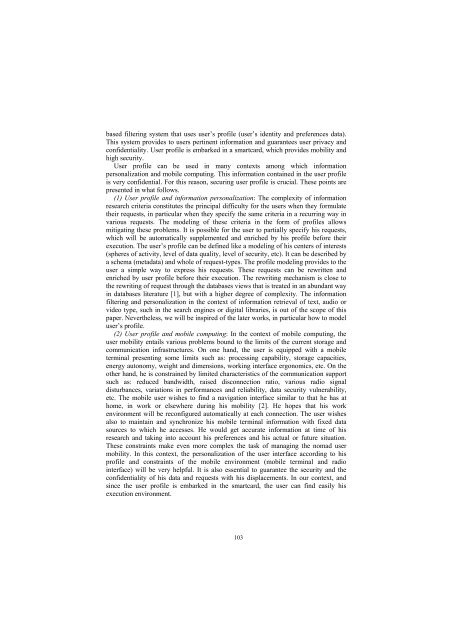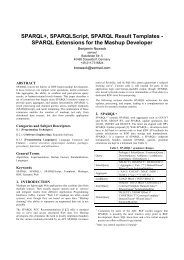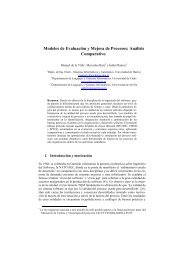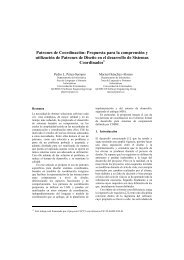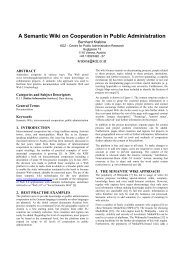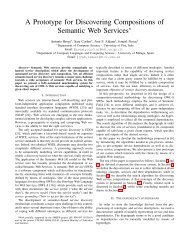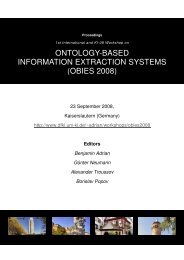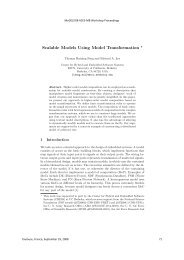Sim-Filter: User Profile based Smart Information Filtering and - FTP
Sim-Filter: User Profile based Smart Information Filtering and - FTP
Sim-Filter: User Profile based Smart Information Filtering and - FTP
Create successful ePaper yourself
Turn your PDF publications into a flip-book with our unique Google optimized e-Paper software.
ased filtering system that uses user’s profile (user’s identity <strong>and</strong> preferences data).<br />
This system provides to users pertinent information <strong>and</strong> guarantees user privacy <strong>and</strong><br />
confidentiality. <strong>User</strong> profile is embarked in a smartcard, which provides mobility <strong>and</strong><br />
high security.<br />
<strong>User</strong> profile can be used in many contexts among which information<br />
personalization <strong>and</strong> mobile computing. This information contained in the user profile<br />
is very confidential. For this reason, securing user profile is crucial. These points are<br />
presented in what follows.<br />
(1) <strong>User</strong> profile <strong>and</strong> information personalization: The complexity of information<br />
research criteria constitutes the principal difficulty for the users when they formulate<br />
their requests, in particular when they specify the same criteria in a recurring way in<br />
various requests. The modeling of these criteria in the form of profiles allows<br />
mitigating these problems. It is possible for the user to partially specify his requests,<br />
which will be automatically supplemented <strong>and</strong> enriched by his profile before their<br />
execution. The user’s profile can be defined like a modeling of his centers of interests<br />
(spheres of activity, level of data quality, level of security, etc). It can be described by<br />
a schema (metadata) <strong>and</strong> whole of request-types. The profile modeling provides to the<br />
user a simple way to express his requests. These requests can be rewritten <strong>and</strong><br />
enriched by user profile before their execution. The rewriting mechanism is close to<br />
the rewriting of request through the databases views that is treated in an abundant way<br />
in databases literature [1], but with a higher degree of complexity. The information<br />
filtering <strong>and</strong> personalization in the context of information retrieval of text, audio or<br />
video type, such in the search engines or digital libraries, is out of the scope of this<br />
paper. Nevertheless, we will be inspired of the later works, in particular how to model<br />
user’s profile.<br />
(2) <strong>User</strong> profile <strong>and</strong> mobile computing: In the context of mobile computing, the<br />
user mobility entails various problems bound to the limits of the current storage <strong>and</strong><br />
communication infrastructures. On one h<strong>and</strong>, the user is equipped with a mobile<br />
terminal presenting some limits such as: processing capability, storage capacities,<br />
energy autonomy, weight <strong>and</strong> dimensions, working interface ergonomics, etc. On the<br />
other h<strong>and</strong>, he is constrained by limited characteristics of the communication support<br />
such as: reduced b<strong>and</strong>width, raised disconnection ratio, various radio signal<br />
disturbances, variations in performances <strong>and</strong> reliability, data security vulnerability,<br />
etc. The mobile user wishes to find a navigation interface similar to that he has at<br />
home, in work or elsewhere during his mobility [2]. He hopes that his work<br />
environment will be reconfigured automatically at each connection. The user wishes<br />
also to maintain <strong>and</strong> synchronize his mobile terminal information with fixed data<br />
sources to which he accesses. He would get accurate information at time of his<br />
research <strong>and</strong> taking into account his preferences <strong>and</strong> his actual or future situation.<br />
These constraints make even more complex the task of managing the nomad user<br />
mobility. In this context, the personalization of the user interface according to his<br />
profile <strong>and</strong> constraints of the mobile environment (mobile terminal <strong>and</strong> radio<br />
interface) will be very helpful. It is also essential to guarantee the security <strong>and</strong> the<br />
confidentiality of his data <strong>and</strong> requests with his displacements. In our context, <strong>and</strong><br />
since the user profile is embarked in the smartcard, the user can find easily his<br />
execution environment.


